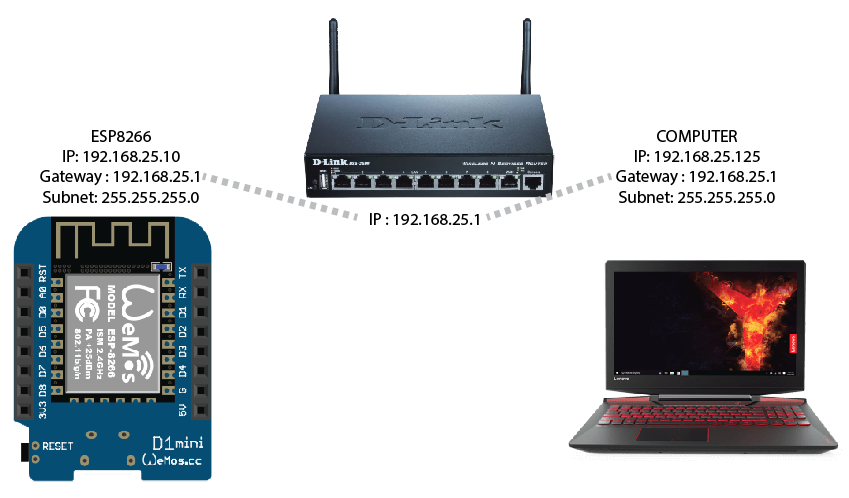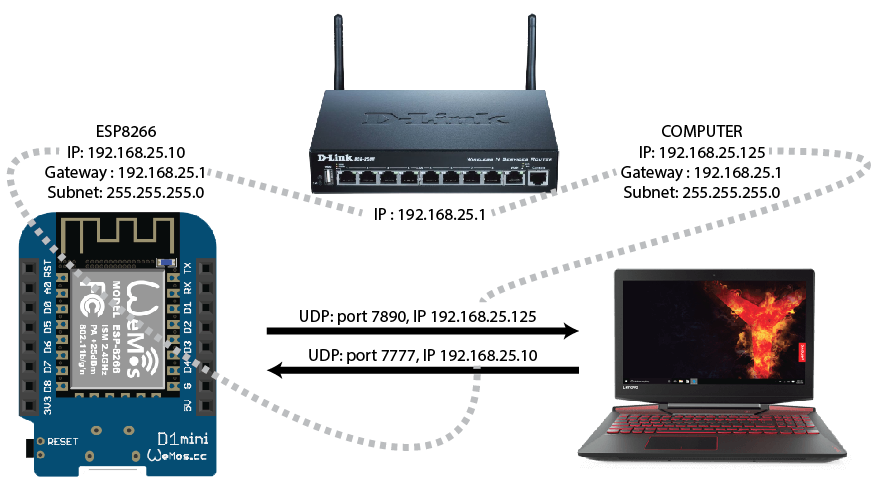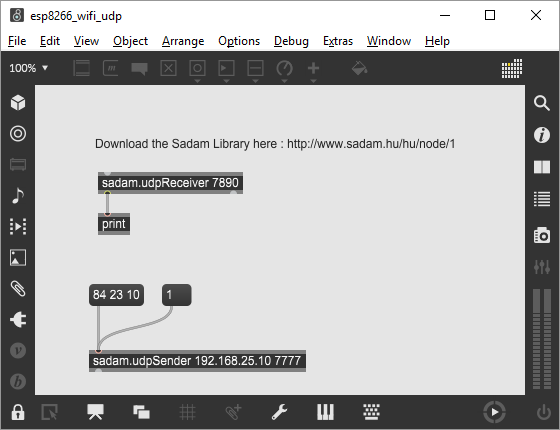Contents (hide)
1. Exemple de code pour se connecter à un réseau WIFI

// INCLUDE ESP8266WiFi:
#include <ESP8266WiFi.h>
// Please change the following values with your network settings:
const char* ssid = "PetitPet";
const char* password = "freedomostie";
IPAddress ip(192, 168, 25, 10);
IPAddress gateway(192, 168, 25, 1);
IPAddress subnet(255, 255, 255, 0);
//===========
//== SETUP ==
//===========
void setup() {
// INITIATE SERIAL COMMUNICATION FOR DEBUGGING.
Serial.begin(57600);
Serial.println("***STARTING WIFI***");
// BEGIN WIFI
WiFi.config(ip , gateway , subnet );
WiFi.begin(ssid, password);
// WAIT UNTIL CONNECTED
while (WiFi.status() != WL_CONNECTED) {
Serial.print(".");
delay(10);
}
// PRINT CONNECTION SETTINGS
Serial.println();
Serial.println("WiFi connected, IP address: ");
Serial.println( WiFi.localIP() );
}
void loop() {
}
2. Exemple pour se connecter à un réseau WIFI et ouvrir une connexion UDP

2.1 Code Arduino
// INCLUDE ESP8266WiFi:
#include <ESP8266WiFi.h>
// Please change the following values with your network settings:
const char* ssid = "NOM DU RESEAU";
const char* password = "MOT DE PASSE";
IPAddress ip(192, 168, 25, 10);
IPAddress gateway(192, 168, 25, 1);
IPAddress subnet(255, 255, 255, 0);
// INCLUDE ESP8266 UDP
#include <WiFiUdp.h>
WiFiUDP udp;
// UDP
int udpReceivePort = 7777;
IPAddress udpTxIp = IPAddress(192, 168, 25, 125);
int udpTxPort = 7890;
// UDP BUFFERS
#define UDP_RX_BUFFER_MAX_SIZE 256
char udpRxBuffer[UDP_RX_BUFFER_MAX_SIZE];
#define UDP_TX_BUFFER_MAX_SIZE 256
char udpTxBuffer[UDP_TX_BUFFER_MAX_SIZE];
//===========
//== SETUP ==
//===========
void setup() {
// INITIATE SERIAL COMMUNICATION FOR DEBUGGING.
Serial.begin(57600);
Serial.println("***STARTING WIFI***");
// BEGIN WIFI
WiFi.config(ip , gateway , subnet );
WiFi.begin(ssid, password);
// WAIT UNTIL CONNECTED
while (WiFi.status() != WL_CONNECTED) {
Serial.print(".");
delay(10);
}
//
// PRINT CONNECTION SETTINGS
Serial.println();
Serial.println("WiFi connected, IP address: ");
Serial.println( WiFi.localIP() );
udp.begin(udpReceivePort); // BEGIN LISTENING ON UDP PORT udpReceivePort
}
//==========
//== LOOP ==
//==========
void loop() {
// CHECK IF AN UDP PACKET WAS RECEIVED:
// udp.parsePacket() RETURNS ture IF IT AN UDP PACKET WAS RECEIVED
if ( udp.parsePacket() ) {
// COPY THE PACKET INTO A BUFFER
// udp.read() RETURNS THE NUMBER OF chars THAT WERE RECEIVED
int packetSize = udp.read(udpRxBuffer, UDP_RX_BUFFER_MAX_SIZE);
Serial.println("***UDP***");
Serial.print("Received packet of size: ");
Serial.println(packetSize);
Serial.print("From: ");
IPAddress remoteIp = udp.remoteIP();
Serial.println(remoteIp);
// DO SOMETING WITH THE DATA IN THE RX BUFFER
// FOR EXAMPLE, PRINT IT OUT
Serial.print("CONTENTS: ");
for ( int i=0; i < packetSize; i++ ) {
Serial.print((int) udpRxBuffer[i]);
Serial.print(" ");
}
Serial.println();
// SEND SOME DATA BACK
sendUdpData();
}
}
//===================
//== SEND UPD DATA ==
//===================
void sendUdpData() {
// PUT 3 RANDOM BYTES IN THE TX BUFFER
udpTxBuffer[0] = 12;
udpTxBuffer[1] = 255;
udpTxBuffer[2] = 255;
udp.beginPacket( udpTxIp , udpTxPort );
udp.write( udpTxBuffer , 3 );
udp.endPacket();
}
2.2 Code Max

<pre><code> ----------begin_max5_patcher---------- 526.3ocsU0zabBCD8Lqz9evxm2xh8xm4Vk5wdp4XUUkWvM3HvFYaBaZT+uW+ Azfxx1rAkfPX4wimwu277vSa2D.OJNQUPvMfuCBBdxXIvYyZIXxP.rkbprgn bNBKEssTtFtabQM8j1svWDC7FAoBnqofaIUjVvWYGkD4ifZpjZboVq6tY+9g ggPkc8v598lWtnhtG8u.xpbgSb79Ogd1JuukwanZ2g.MYsinKqY769ojVp83 HIMLZGHtv8EcvNfiBi.+XVjD85oPE4r9msarilgcWMQvoCly347fGZ8UceiV RYOPkfr7hnEg2aGcoN.kmY+hhSbnCeYzgmL+KAWqX+l5huYCS189peri5iOr goL0V.jYJwOGU614jVmSvOKYjF36Nu0IYyjUyno70RSHbtc3.90noOPQvsTd kQBfJvgnz7PbRHJBjYdVBoYqPtG6.WpWJfxdMnhtXk2WwWMSzRUJxczyohEu YmtLRw+GjhvdUeg6pMtHLYsH8CAl4w.7A.ZwK5wucz5qqifMIY8k0yAqOFla 57y586NH1EdAEnD8xxoHN15BL6vTQUZFmnYB9Lmx8NcYt9pSW70jtr2szkt9 zMRtjtNSme03N7YxHjtWHsyy24my39491wPI8A1zV7ETHQZDFZipnW5a9dJc TLAaM+1Tx6YNuMVrX0lZmV01rV0Q7nxoo2tw3veAtkSx3A -----------end_max5_patcher----------- </code></pre>
3. Code Processing
// PRESS A KEY TO SEND AN UDP PACKET
// =================================
// Install the UDP library from the library manager
// import UDP library
import hypermedia.net.*;
UDP udp; // define the UDP object
void setup() {
size(200,200);
// create a new datagram connection on port 6000
// and wait for incomming message
udp = new UDP( this, 7890 );
//udp.log( true ); // <-- printout the connection activity
udp.listen( true );
}
void draw() {
background(0);
}
void keyPressed() {
byte[] data = new byte[3];
data[0] = (byte)key;
data[1] = (byte)random(256);
data[2] = (byte)random(256);
print("Sending: ");
for ( int i =0 ; i < data.length; i++ ) {
print( (data[i] & 0xFF) +" "); // The & 0xFF converts the signed byte to unsigned byte
}
println();
udp.send( data, "192.168.25.10" , 7777 );
}
/**
* To perform any action on datagram reception, you need to implement this
* handler in your code. This method will be automatically called by the UDP
* object each time he receive a nonnull message.
*/
void receive( byte[] data, String ip, int port ) {
// print the result
print( "received from "+ip+" on port "+port +":" );
for ( int i =0 ; i < data.length; i++ ) {
print( (data[i] & 0xFF) +" "); // The & 0xFF converts the signed byte to unsigned byte
}
println();
}